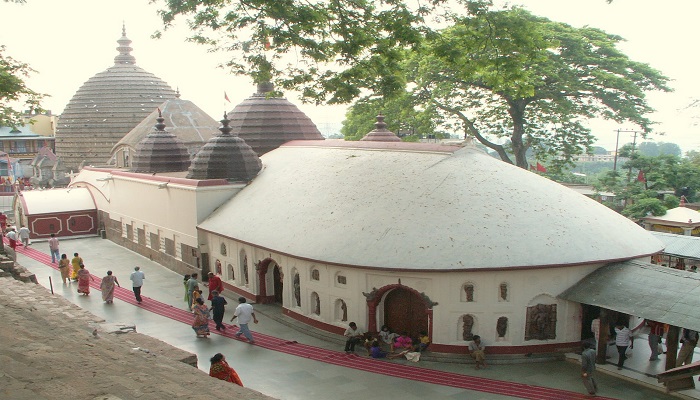
Kamakhya temple is a famous pilgrimage situated at Guwahati, Assam. The temple is located on the Nilachal hill in Guwahati at about 8 kms from the railway station.
The Kamakhya temple is dedicated to the tantric goddesses. Kamakhya temple is a famous pilgrimage situated at Guwahati, Assam. Kamakhya Temple, Assam is one among the 52 shakti peeths of India.
Apart from the deity Kamakhya Devi, the compound of the temple houses 10 other avatars of Kali namely Dhumavati, Matangi, Bagola, Tara, Kamala, Bhairavi, Chinnamasta, Bhuvaneshwari and Tripuara Sundari.
There is no image of Shakti here. Within a corner of the cave in the temple, there is a sculptured image of the yoni of the goddess, which is the object of reverence. A natural spring keeps the stone moist.
The temple of Kamakhya has a very interesting story of its origin. of the 108 shathi peeths, it is said that 52 them are in India.
The story of the Shakti peeths goes like this; once Sati fought with her husband Shiva to attend her father’s great yagna. At the grand yagna, Sati’s father Daksha insulted her husband.
Sati was angered and in her shame, she jumped into the fire and killed herself.
When Shiva came to know that his beloved wife had committed suicide, he went insane with rage.
He placed Sati’s dead body on his shoulders and did the tandav or dance of destruction.
To calm him down, Vishnu cut the dead body with his chakra. The 108 places where Sati’s body parts fell are called Shakti peeths.
Kamakhya temple is special because Sati’s womb and vagina fell here.
The temple got the name Kamakhaya, as the legend goes that the God of love, Kamadeva had lost his virility due to a curse. He sought out the Shakti’s womb and genitals and was freed from the curse.
This is where ‘love’ gained his potency and thus, the deity ‘Kamakhya’ devi was installed and worshipped here. Some people also believe that the Kamakhya temple is a place where Shiva and devi Sati had their romantic encounters. As the Sanskrit word for lovemaking is ‘kama’, the place was named Kamakhya.
Kamakhya devi is famous as the bleeding goddess. The mythical womb and vagina of Shakti are supposedly installed in the ‘Garvagriha’ or sanctum of the temple. In the month of Ashaad (June), the goddess bleeds or menstruates.
At this time, the Brahmaputra river near Kamakhya turns red. The temple then remains closed for 3 days and holy water is distributed among the devotees of Kamakhya devi.
this is called as Ambuwasi Puja: This is a fertility festival. On the fourth day, the temple is opened with great festivity
There is no scientific proof that the blood actually turns the river red. Some people say that the priests pour vermilion into the waters. But symbolically, menstruation is the symbol of a woman’s creativity and power to give birth.
So, the deity and temple of Kamakhya celebrate this ‘shakti’ or power within every woman.
This temple was destroyed in early 16th century and then rebuilt in the 17th century by king Nara Narayana of Cooch Bihar.
The current temple has a beehive-like Shikhara with delightful sculptured panels and images of Ganesha and other Hindu Gods and Goddesses on the outside.
The temple consists of three major chambers. The western chamber is large and rectangular and is not used by general pilgrims for worship. The middle chamber is a square with a small idol of the Goddess, a later addition. The walls of this chamber contain sculpted images of Nara Narayana, related inscriptions and other Gods.
Apart from the daily puja offered to the Devi, a number of special pujas are also held around the year in Kamakhya Temple. These pujas are Durga Puja, Pohan Biya, Durgadeul, Vasanti puja, Madandeul, Ambuvaci and Manasa puja.

Post Your Comments